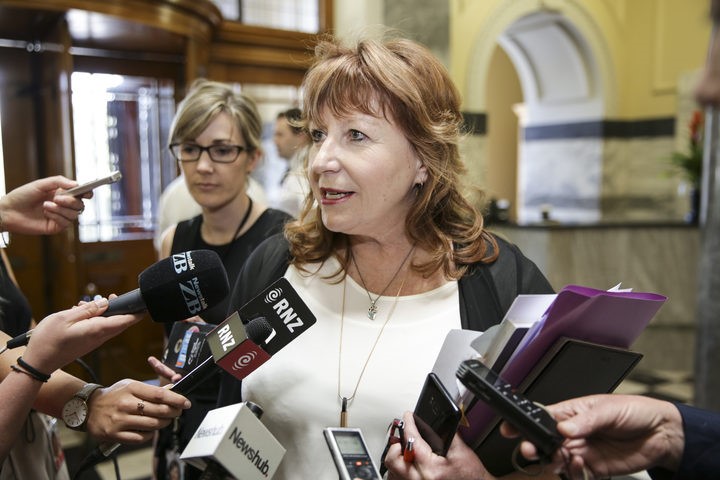From Mediawatch, 10:08 pm on 16 May 2018
Colin Peacock - mediawatch@radionz.co.nz & @MediawatchNZ
The government has allocated an additional $15 million in the Budget for public broadcasting, but it is not clear where the new investment will go.

Photo: RNZ / Richard Tindiller
Broadcasting, Communications and Digital Media Minister Clare Curran said the funding boost recognises “the importance of well-resourced public media".
It is a lot less than Labour’s pre-election promise of $38 million a year for RNZ and public broadcasting funding agency New Zealand On Air to deliver "quality New Zealand programming and journalism’".
But Ms Curran said there would be further funding in future Budgets.
An advisory group set up by Ms Curran has yet to make recommendations as to how the new funds will be split between RNZ and New Zealand On Air (NZOA), which allocates public money to a range of media platforms on a contestable basis.
“This is good news and signals the government’s commitment to investing in a stronger, multimedia RNZ that provides freely-available, high-quality journalism and programming,” RNZ's chief executive Paul Thompson said.
“We are also encouraged by the indication that further funding will be allocated in future budgets for full implementation of the government’s public media policy.”
Leaving the freeze behind
Top brass at RNZ and New Zealand on Air did not need to bother scanning the Budget too closely in recent years.
The former government told both in 2009 there would be no new funds for broadcasting for the foreseeable future. After that, they effectively gave up on even bidding for any more.
"I don't think there's anybody on this board who is going to go whingeing to the government asking for more money ... when people are in corridors in hospitals or Christchurch is literally crawling out of the rubble,” RNZ’s chair at the time, Richard Griffin, said in 2011.
RNZ sold assets - including two grand pianos - and briefly explored the possibility of sponsorship and donations during the freeze. Reporting posts in Palmerston North, Tauranga and Queenstown were scrapped and offices closed.
In 2016, Mr Griffin said it was "pointless beating your head against a brick wall ... of reality," and that even preparing a plan to ask for more money cost money.
But the following year, the freeze eased for RNZ when the National-led government granted an increase of $2.84 million, bringing the broadcaster’s annual budget to $34.8m.
There was no such boost for NZOA though.
“Our annual purchasing power to fund content is now 21 percent lower than in 2010,” NZOA said in 2017. It has had around $95m a year in contestable funding for TV, radio and digital content in recent years.
But things changed when the government changed last year.
Labour went into the election pledging to boost “public media” with $38 million for RNZ and NZ On Air to provide more “quality New Zealand programming and journalism”.
Ms Curran said the bulk of the funding would go to RNZ to create a fully multimedia platform to be called RNZ+.
Last month RNZ and NZOA pitched proposals for the funding to a recently-appointed advisory group.
TV channel plan hits headwinds
Controversially, Clare Curran has said she wanted a full TV channel run by RNZ on Freeview, offering more news and current affairs, children's content and drama.
The boss of major media company MediaWorks claimed it could wipe out his business and hired a lobbyist to talk her out of it. Fairfax NZ (now Stuff) chief executive Sinead Boucher questioned "piling more money into state-owned media".
Even RNZ’s chief executive Paul Thompson and chair Richard Griffin said a stand-alone TV channel was not what they had in mind.
That - and the fallout from that meeting between
the minister and the now-former RNZ executive leading its
multimedia transition, Carol Hisrchfeld - cast doubt over
the entire RNZ+ project.
But while the TV channel idea has been cast as Curran’s pet project in the media, it’s been Labour policy for at least four years.
“This station is likely be within Radio New Zealand,” Labour’s Kris Faafoi said ahead of the 2014 election.
Working groups would “look closely at the experiences of TVNZ6 and TVNZ7,” he said.
That was not a happy experience.
The former Labour-led government gave state-owned TVNZ $80m over five years to create non-commercial TV local content channels.
But when the money ran out in 2012, the channels died. The National-led government scrapped Labour’s TVNZ charter.
No state-owned broadcaster would sign up for a public TV channel again without a guarantee of substantial and sustained funding.
TV costs a lot more to make than radio or online content.
The cost of TVNZ7 was estimated to be around $12m-$17m per year between 2007 and 2012.
Māori Television now receives around $33m in direct public funding, and many of its key programmes are paid for through the publicly-funded agency Te Mangai Paho.
Furthermore, RNZ needs substantial investments in digital technology and essential upgrades deferred in the years of frozen funding.
Staff who have not had a significant pay rise in years will also push for an increase.



 Binoy Kampmark: Bratty Royal - Prince Harry And Bespoke Security Protection
Binoy Kampmark: Bratty Royal - Prince Harry And Bespoke Security Protection Keith Rankin: Make Deficits Great Again - Maintaining A Pragmatic Balance
Keith Rankin: Make Deficits Great Again - Maintaining A Pragmatic Balance Richard S. Ehrlich: China's Great Wall & Egypt's Pyramids
Richard S. Ehrlich: China's Great Wall & Egypt's Pyramids Gordon Campbell: On Surviving Trump’s Trip To La La Land
Gordon Campbell: On Surviving Trump’s Trip To La La Land Ramzy Baroud: Famine In Gaza - Will We Continue To Watch As Gaza Starves To Death?
Ramzy Baroud: Famine In Gaza - Will We Continue To Watch As Gaza Starves To Death? Peter Dunne: Dunne's Weekly - A Government Backbencher's Lot Not Always A Happy One
Peter Dunne: Dunne's Weekly - A Government Backbencher's Lot Not Always A Happy One